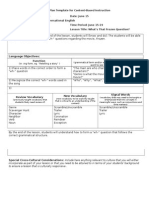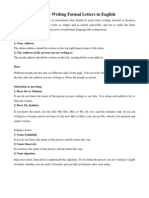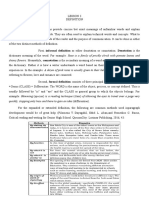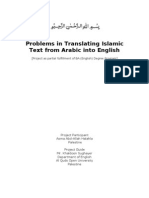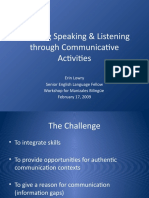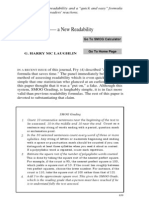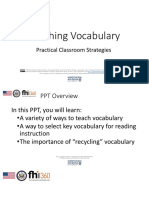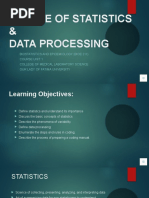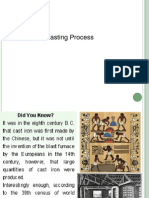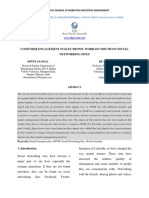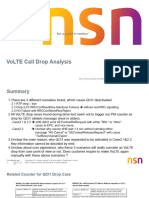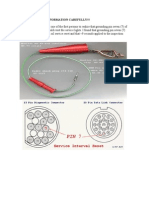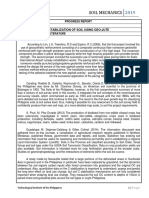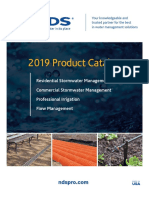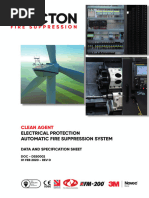0 ratings0% found this document useful (0 votes)
149 viewsBusiness Letter
Business Letter
Uploaded by
Julia Mariz MacawiliThis document provides guidance on writing business letters. It discusses the standard elements and layout of business letters such as the heading, opening, body, and closing. The body should follow the 6Cs - be clear, concise, consistent, complete, courteous, and correct. Business letters aim to inform, instruct, reply, or convince/persuade. Proper business correspondence is formal yet polite. Effective letters are brief, to the point, avoid jargon, and use "you" attitude. Common letter types like sales, collection, and job application letters each have their own objectives. Covering letters should highlight relevance and interest in the position.
Copyright:
© All Rights Reserved
Available Formats
Download as PPT, PDF, TXT or read online from Scribd
Business Letter
Business Letter
Uploaded by
Julia Mariz Macawili0 ratings0% found this document useful (0 votes)
149 views13 pagesThis document provides guidance on writing business letters. It discusses the standard elements and layout of business letters such as the heading, opening, body, and closing. The body should follow the 6Cs - be clear, concise, consistent, complete, courteous, and correct. Business letters aim to inform, instruct, reply, or convince/persuade. Proper business correspondence is formal yet polite. Effective letters are brief, to the point, avoid jargon, and use "you" attitude. Common letter types like sales, collection, and job application letters each have their own objectives. Covering letters should highlight relevance and interest in the position.
Original Title
BUSINESS-LETTER
Copyright
© © All Rights Reserved
Available Formats
PPT, PDF, TXT or read online from Scribd
Share this document
Did you find this document useful?
Is this content inappropriate?
This document provides guidance on writing business letters. It discusses the standard elements and layout of business letters such as the heading, opening, body, and closing. The body should follow the 6Cs - be clear, concise, consistent, complete, courteous, and correct. Business letters aim to inform, instruct, reply, or convince/persuade. Proper business correspondence is formal yet polite. Effective letters are brief, to the point, avoid jargon, and use "you" attitude. Common letter types like sales, collection, and job application letters each have their own objectives. Covering letters should highlight relevance and interest in the position.
Copyright:
© All Rights Reserved
Available Formats
Download as PPT, PDF, TXT or read online from Scribd
Download as ppt, pdf, or txt
0 ratings0% found this document useful (0 votes)
149 views13 pagesBusiness Letter
Business Letter
Uploaded by
Julia Mariz MacawiliThis document provides guidance on writing business letters. It discusses the standard elements and layout of business letters such as the heading, opening, body, and closing. The body should follow the 6Cs - be clear, concise, consistent, complete, courteous, and correct. Business letters aim to inform, instruct, reply, or convince/persuade. Proper business correspondence is formal yet polite. Effective letters are brief, to the point, avoid jargon, and use "you" attitude. Common letter types like sales, collection, and job application letters each have their own objectives. Covering letters should highlight relevance and interest in the position.
Copyright:
© All Rights Reserved
Available Formats
Download as PPT, PDF, TXT or read online from Scribd
Download as ppt, pdf, or txt
You are on page 1of 13
BUSINESS LETTERS
Study Material For The students of B. SC. (Hons.)
Chemistry I Year Section A
:By Dr. Shubha Dwivedi
Assistant Professor
Department of English
ARSD College
BUSINESS LETTERS
Heading Opening Body Closing
1. Consists of: Contains the message
Printed Letterhead
2. Name of the person Follow the 6Cs
addressed Be--- Complementary
Contains 3. His/her designation •Clear Close
4. The address- •Concise
•If your salutation is
(a) Street no. and •Consistent
by name, Close it with
•Name of the name •Complete
“Yours Sincerely”
organization (b) City •Courteous
•If it is Dear Sir/s
•Address with telephone, (c) State •Correct
Or Dear Madam
fax nos. (d) Pin code
Close it with
• and e-mail address 5. The Salutation
“Yours Faithfully”
•Company’s logo 6. The subject-
•References Written either in block
•Date, Day, Month, Year letters or underlined
Written Communication
• Written communication is formal and precise.
• It requires a formal beginning and ending.
• Oral interpersonal communication is most
often informal.
• Whereas in oral communication one can
depend on tone of voice, facial expressions
or gestures to put across one’s message, in
written communication one has to depend
only on the formal, written words to get the
message across.
Letters
• Letters are the most important means of written
communication as they become permanent
records and can be referred to in future.
• Maintaining customer relations, handling
problems, exchange of information, and
maintaining goodwill requires skillful letter
writing.
• Reasons for writing a formal letter:
• To inform-To tell someone about something
• To instruct/order –To make somebody do
something
• To reply- To reply to some communication
• To convince/persuade- To make somebody
interested in you or in your product
Features of Business Correspondence
• The overall tone of a business letter is restrained formality.
• Your letters should be brief but not curt.
• They should be polite and easily comprehensible.
• Plan your letter-
1. the reason and objective of writing
2. To whom you are writing-adjust your style according to the needs of
the person whom you are writing, his designation in the organization
etc.
3. When are you going to write? Do you have a deadline to meet?
4. What will be the layout and construction of the letter?
• Formal letters should be short and to the point and devoid of
complex sentences and jargon laded language.
• Formal letters must incorporate You-Attitude- that is show respect
for readers’ needs, intelligence, integrity and the POV.
• A Dictionary and thesaurus are a good letter writer’s constant companions.
• Pick the right word
• Avoid repetition of words and verbosity
• Building one’s word power aids to using words with consummate skill
• Avoid cliches
• Spontaneity in a letter ensures smooth reading
• Make the letter balanced and positive in approach. Avoid using negative words like
‘failure’, ‘refuse’, ‘sorry’, ‘damage’ etc.
• Good business letters maintain ethical and moral standards, and show a sense of
legitimacy.
• Learn to mitigate the hardship or adverse impact of the message through choice of
words and manner of presentation.
• Bring a unique perspective and experience to the letter by adding imagination and
creativity to it.
• The letter should reflect enthusiasm and innovative temper of the writer.
• A positive and progressive approach to writing letters generates regard and creates
goodwill for the writer.
• Prefer friendly and conversational style over stilted, dull and stiff writing.
• Clarity of goal should be reflected in both thought and expression.
• The most effective business letters are those that show the writer’s interest in the
receiver. Therefore, adopt “you” attitude.
• An effective letter emphasizes all important points by carefully positioning them in
sentences and paragraph.
• Effective business letters have tactful approach .Certain problems call for a ‘middle
ground ‘ approach.
FORMS OF LAYOUT AND PARTS OFA BUSINESS LETTER
• Full Block Form
• Modified Block Form
• Semi Indented Form
• Hanging Indention Form
• Standard Elements
• Heading or Letterhead
• Reference Number
• Date
• Inside Address
• Mode of Address
• Salutation
• Subject Line
• Body of the Letter
• Formal Close
• Complimentary Close
• Signature block/slot
• Additional Elements
• Addressee Notation- labels such as ‘PERSONAL’,
‘CONFIDENTIAL’, ‘URGENT’, ‘PLEASE REDIRECT’ etc, typed in all
capitals, two spaces above the inside address.
• Attention Line-Draws the attention of a particular individual or
department for action- ‘Attention Accounts Officer’, ‘Attention
Section Officer’ etc.
• Subject Line-The purpose of the letter; helps in filing the letter for
future reference
• Reference initials-A set of two initials formed by using the initials of
one who dictates the letter and followed by the initials of the person
who types the letter. There are two ways to do it-SD/VM or SD:VM
• Enclosure Notation: Enclosure: Resume
• Postscript- a second afterthought has the notation ‘PS’or ‘P.S.’
• ‘CC’ or Carbon Copy Notation
• ‘PC’ or Photocopy Notation-pc: Mr. P.K. Arora
Business Letter Types And Their Objectives
Types Objectives
Credit To enquire or request for loan
Collection To collect past due accounts
Order To place an order for products or services
Inquiry To enquire the status of sth; price lists;catalogues
Claim To lodge a complain and ask for a remedy
Adjustment To inform how the complaint would be taken care of
Sales To sell /promote a product or service
Fundraising To request the readers to donate money or time
Job To apply for an employment
Application
Covering Letter
A covering Letter –
• Mentions the post you have applied for
• Whether you are sending the filled –in application form or a C.V., or both.
• Expand on some points about background or experience
• Emphasize the candidate’s interest in the job and suitability for it.
• Show some knowledge of the company
• Why you would like to be employed by the company
• That you look forward to hearing from them
• Examples:
Showing Eligibility-
• I have the requisite qualifications and experience to be a suitable candidate for the post.
• A C.V. giving the details of my qualifications and experience is attached for your reference.
• Please find enclosed a copy of my detailed C.V.
Showing Willingness-
• A position with your firm will give me the kind of experience I am looking for.
• Yours is a well-known company and given the opportunity, I believe that I shall be able to develop
myself professionally in your company.
Referring to Future Contact-
• I look forward to hearing from you.
• I would be happy to appear for an interview at any time convenient to you.
• I look forward to being called for an interview.
•
Ending of a Self application
Be very polite
Show confidence.
Be brief.
If you should find me a suitable candidate for the post advertised, I am
confident that
I shall satisfy your needs.
I shall live upto your expectations.
It will be a mutually rewarding experience.
I shall be happy to
Appear for an interview.
Work for your firm.
Meet the challenges of the job.
Questions For Self-Assessment
• Draft a sales letter introducing a new hand sanitizer that contains
Aloe Vera, Neem and Tulsi as prime ingredients and which provides
complete protection from diseases and infection.
• Write a persuasive letter to the Commissioner of the Municipal
corporation for garbage collection and the regular spraying of
disinfectant in different nooks and corners of the city.
• Revise the following sentences to improve you-attitude
• i) We will call you at our convenience to discuss whether we will hire
you for the job.
• Your service contract with us is hereby terminated.
• By this time next week, we will have made our decision on your
refund request.
• We can arrange for our tow truck to pick up your car between 10 AM
and 2 PM.
References
• Locker, O Kitty, Stephen Kyo Kaczmarek. Business Communication.
New Delhi: Tata McGraw-Hill Publishing Company Limited, 2007.
• Malhotra Prerna, et al. Business Communication. New Delhi: Book
Age Publications, 2015.
• Soundarraj, Francis. Speaking and Writing For Effective Business
Communication. New Delhi: Macmillan,2008.
You might also like
- Writing Professional CorrespondenceDocument23 pagesWriting Professional CorrespondenceTeresa V. ArceoNo ratings yet
- Tesol Lesson Plan 1Document10 pagesTesol Lesson Plan 1api-289422703No ratings yet
- The Standard Setting Process International Financial Reporting StandardsDocument5 pagesThe Standard Setting Process International Financial Reporting Standardsroland rukandeNo ratings yet
- Bad Resume ExampleDocument5 pagesBad Resume ExampleDAVE HOWARDNo ratings yet
- Informative Speech GuidelinesDocument2 pagesInformative Speech GuidelinesFluffyBearssNo ratings yet
- Action Pack 11 ABDocument82 pagesAction Pack 11 ABMuna MohdNo ratings yet
- 01 BTEC Assignment ProcessDocument4 pages01 BTEC Assignment ProcessJames CarpenterNo ratings yet
- شرح لجميع القواعد PDFDocument35 pagesشرح لجميع القواعد PDFEd-daoudi Abdessadek100% (4)
- Objectives of Written CommunicationDocument44 pagesObjectives of Written Communicationarjunbudhraja13No ratings yet
- BTEC - Unit 2 AssignmentDocument5 pagesBTEC - Unit 2 Assignmentrk0522No ratings yet
- Business LetterDocument17 pagesBusiness LetterSaman KhanNo ratings yet
- Types of EssaysDocument9 pagesTypes of EssaysAli khanNo ratings yet
- Parts of The Business Letters 1Document8 pagesParts of The Business Letters 1Keisha Tereso100% (1)
- Formal and Informal Register Part 2Document3 pagesFormal and Informal Register Part 2Ignacio NoriaNo ratings yet
- Writing Emails Formal and Informal CommunicationDocument16 pagesWriting Emails Formal and Informal CommunicationJacques LightNo ratings yet
- Communication Skills Definition PDFDocument2 pagesCommunication Skills Definition PDFJoshua100% (2)
- Business Correspondence PPT 1Document44 pagesBusiness Correspondence PPT 1Alexandru MilotinNo ratings yet
- Chapter 3 - Lesson 3 - Making InquiriesDocument27 pagesChapter 3 - Lesson 3 - Making InquiriesRica mae NarioNo ratings yet
- Technical Writing - UniversityDocument4 pagesTechnical Writing - UniversityPercival PelaezNo ratings yet
- How To Write A Polite and Professional Email To Your TeacherDocument4 pagesHow To Write A Polite and Professional Email To Your TeacherDarshana MathurNo ratings yet
- Rules For Writing Formal Letters in EnglishDocument4 pagesRules For Writing Formal Letters in EnglishKamesh NagarajanNo ratings yet
- What Is Functional EnglishDocument1 pageWhat Is Functional EnglishKhalid Mahmood AwanNo ratings yet
- Reading and Writing Lesson 2Document1 pageReading and Writing Lesson 2Joshua Lander Soquita CadayonaNo ratings yet
- How To Make A Resume TemplateDocument6 pagesHow To Make A Resume Templateafmrpaxgfqdkor100% (1)
- Lesson 6: WRITING Business and TechnicalDocument20 pagesLesson 6: WRITING Business and TechnicalMark Anthony NacuelaNo ratings yet
- Process Description PowerpointDocument23 pagesProcess Description PowerpointPindoterONo ratings yet
- IELTS Essay StructuresDocument10 pagesIELTS Essay StructuresAhmed SamirNo ratings yet
- Basics of ResearchDocument10 pagesBasics of ResearchAnkit JindalNo ratings yet
- Writing Assessment and Evaluation Checklist - PeerDocument1 pageWriting Assessment and Evaluation Checklist - PeerMarlyn Joy YaconNo ratings yet
- Problems in Translating Islamic Text From Arabic Into EnglishDocument32 pagesProblems in Translating Islamic Text From Arabic Into Englishmyscribd555100% (7)
- Allama Iqbal Open University, Islamabad (Department of English Language and Applied Linguistics)Document3 pagesAllama Iqbal Open University, Islamabad (Department of English Language and Applied Linguistics)Shakil AhmadNo ratings yet
- Edc 361 Course Outline 2023Document3 pagesEdc 361 Course Outline 2023Amos Bona100% (1)
- Teaching Speaking & Listening Through Communicative ActivitiesDocument29 pagesTeaching Speaking & Listening Through Communicative ActivitiesNor Faa'iza Binti Taib100% (2)
- Developing A Questionnaire To Measure Students' Attitudes Toward The Course Blog - (#176131) - 155896Document11 pagesDeveloping A Questionnaire To Measure Students' Attitudes Toward The Course Blog - (#176131) - 155896Merry Ann TamalonNo ratings yet
- Critical Writing ExamplesDocument4 pagesCritical Writing ExamplesAlma De LuzNo ratings yet
- Communication For EmploymentDocument19 pagesCommunication For EmploymentRishavNo ratings yet
- Reading Academic TextDocument25 pagesReading Academic TextRhealyn Marquez67% (3)
- Practice ExamDocument4 pagesPractice ExamMichelle ChengNo ratings yet
- Johnson (1988) Mistake CorrectionDocument8 pagesJohnson (1988) Mistake CorrectionChompNo ratings yet
- Improving Student's Speaking SkillsDocument73 pagesImproving Student's Speaking Skillssabapathy.ramaraju2458No ratings yet
- Difference Between Oral Communication and Written CommunicationDocument5 pagesDifference Between Oral Communication and Written CommunicationAaqibR100% (1)
- Theoretical Course of English GrammarDocument7 pagesTheoretical Course of English GrammarShalva100% (1)
- Teaching SpeakingDocument25 pagesTeaching SpeakingAllung SheinXyu75% (4)
- Business Letters Punctuations and StylesDocument16 pagesBusiness Letters Punctuations and StylesChenna Rose ChanNo ratings yet
- Reading Skills (Lec 2)Document49 pagesReading Skills (Lec 2)BãriNo ratings yet
- What Is A Sales LetterDocument4 pagesWhat Is A Sales LetterBella SullaNo ratings yet
- Think of Word That Best Describe You, Constract A 4-5 Sentences Why? Be Ready To Recite ItDocument38 pagesThink of Word That Best Describe You, Constract A 4-5 Sentences Why? Be Ready To Recite ItRoselyn L. Dela Cruz100% (1)
- Skimming and Scanning Exercise.Document4 pagesSkimming and Scanning Exercise.aliz velasquezNo ratings yet
- Final Exam in Language TestingDocument4 pagesFinal Exam in Language TestingASELA PE?FIEL100% (1)
- What Is Report WritingDocument11 pagesWhat Is Report WritingSujit MauryaNo ratings yet
- SMOG Readability Formula G. Harry McLaughlin (1969)Document8 pagesSMOG Readability Formula G. Harry McLaughlin (1969)rishidwesar5718No ratings yet
- English Speaking Anxiety ThesisDocument8 pagesEnglish Speaking Anxiety Thesistinamclellaneverett100% (1)
- CV - Resume Writing TipsDocument15 pagesCV - Resume Writing TipsengineblockNo ratings yet
- Integrating Language Skills To Efl Learners Through Poems and PoetryDocument9 pagesIntegrating Language Skills To Efl Learners Through Poems and PoetryDanang Dwi PradityaNo ratings yet
- Teaching VocabularyDocument45 pagesTeaching VocabularyAreeka NaveenNo ratings yet
- Grammar Test 2Document3 pagesGrammar Test 2Hanif KurniadiNo ratings yet
- Lesson 1 What Is Technical WritingDocument7 pagesLesson 1 What Is Technical WritingMichaella Portugal FloridaNo ratings yet
- Cafeteria Memo - Improved VersionDocument5 pagesCafeteria Memo - Improved VersionJym Yurick BaltoresNo ratings yet
- Business Letter WritingDocument69 pagesBusiness Letter Writingnavdeep2309No ratings yet
- Business LetterDocument9 pagesBusiness LetterHarshit TripathiNo ratings yet
- Lecture 2Document33 pagesLecture 2Julia Mariz MacawiliNo ratings yet
- 02 - BIOE 211 - Data Presentation (Compressed)Document37 pages02 - BIOE 211 - Data Presentation (Compressed)Julia Mariz MacawiliNo ratings yet
- 01 - BIOE 211 - Nature of Statistics and Data ProcessingDocument26 pages01 - BIOE 211 - Nature of Statistics and Data ProcessingJulia Mariz MacawiliNo ratings yet
- WEEK 2A - Tabon CavesDocument26 pagesWEEK 2A - Tabon CavesJulia Mariz MacawiliNo ratings yet
- WEEK 2 - Katipunan and The Revolution Santiago Alvarez 1Document25 pagesWEEK 2 - Katipunan and The Revolution Santiago Alvarez 1Julia Mariz MacawiliNo ratings yet
- APhO 2009 Q1Document2 pagesAPhO 2009 Q1Robert LascarNo ratings yet
- Dokumen - Tips Katangiang Pisikal NG AsyaDocument17 pagesDokumen - Tips Katangiang Pisikal NG AsyaLara KimNo ratings yet
- Discourse Analysis LECTURE 1Document4 pagesDiscourse Analysis LECTURE 1Sorin Mihai Vass100% (1)
- Metal CastingDocument40 pagesMetal CastingFahmi Sanji AlexanderNo ratings yet
- Urea PlantDocument25 pagesUrea PlantHarsh DholakiyaNo ratings yet
- ETAC ETechnician Standard 2020Document104 pagesETAC ETechnician Standard 2020bNo ratings yet
- Pradeep Kumar Singh: Sub: Application For The Post of Regional ManagerDocument5 pagesPradeep Kumar Singh: Sub: Application For The Post of Regional ManagerMT RANo ratings yet
- Brochure PALMEX 2022 - Part2Document1 pageBrochure PALMEX 2022 - Part2ptgec admNo ratings yet
- 98ki Prodution AnnexureDocument12 pages98ki Prodution AnnexureGous Moin Mohammed Ajaz AliNo ratings yet
- GE LP33 Series 10 4OKVA Technical InstructionsDocument95 pagesGE LP33 Series 10 4OKVA Technical InstructionsMuhammad azeemNo ratings yet
- Adjectives Word List Alphabetical OrderDocument7 pagesAdjectives Word List Alphabetical OrderYasna RojasNo ratings yet
- An Overview On Privacy Preserving Data Mining MethodologiesDocument5 pagesAn Overview On Privacy Preserving Data Mining Methodologiessurendiran123No ratings yet
- Rubric 3 2 1: Dance Analysis QuestionsDocument2 pagesRubric 3 2 1: Dance Analysis QuestionsSeanne ValerieNo ratings yet
- Pe t300 Spec Sheet PDFDocument2 pagesPe t300 Spec Sheet PDFjohnb2bNo ratings yet
- TDS e 006Document2 pagesTDS e 006Paolo VelasquezNo ratings yet
- Consumer Engagement in Electronic Word-Of-mouth On Social Networking SitesDocument29 pagesConsumer Engagement in Electronic Word-Of-mouth On Social Networking SitesGianinaNo ratings yet
- Generators Lighting - Generators Single Phase Diesel - Generator Denyo Diesel Range Risk - Risk AssessmentDocument3 pagesGenerators Lighting - Generators Single Phase Diesel - Generator Denyo Diesel Range Risk - Risk AssessmentBaher Mohamed100% (1)
- VoLTE Call Drop AnalysisDocument21 pagesVoLTE Call Drop AnalysisSamir MezouarNo ratings yet
- BMW ResetDocument6 pagesBMW ResetDaniel BarsanNo ratings yet
- Soil Progress ReportDocument13 pagesSoil Progress ReportJohn Rhey Almojallas Benedicto100% (1)
- NDS Drainage Catalog 2019 PDFDocument36 pagesNDS Drainage Catalog 2019 PDFSopheareak ChhanNo ratings yet
- F-S-O-Hemant Resume UpdatedDocument4 pagesF-S-O-Hemant Resume UpdatedAnonymous e9JhmHA2H0No ratings yet
- Pinto pm5 Tif 02Document24 pagesPinto pm5 Tif 02Salem BawazirNo ratings yet
- Assignment 1Document13 pagesAssignment 1Ronak SutharNo ratings yet
- Process ControlDocument9 pagesProcess ControlRajalakshmi VengadasamyNo ratings yet
- Flight Management System (FMS)Document28 pagesFlight Management System (FMS)rasekakmNo ratings yet
- Superstitious Beliefs Across Daily Lives of IndividualDocument35 pagesSuperstitious Beliefs Across Daily Lives of IndividualMary Angela Asoy BuenaobraNo ratings yet
- DOC-DSS0002 (Clean Agent Data & Specification Sheet) Rev.DDocument6 pagesDOC-DSS0002 (Clean Agent Data & Specification Sheet) Rev.DFire SupNo ratings yet
- Xercise 9.3: Question: EDocument3 pagesXercise 9.3: Question: EUMAR AKBARNo ratings yet
- Amenamkpono Fso Pre LoadingDocument1 pageAmenamkpono Fso Pre LoadingAaronNo ratings yet

